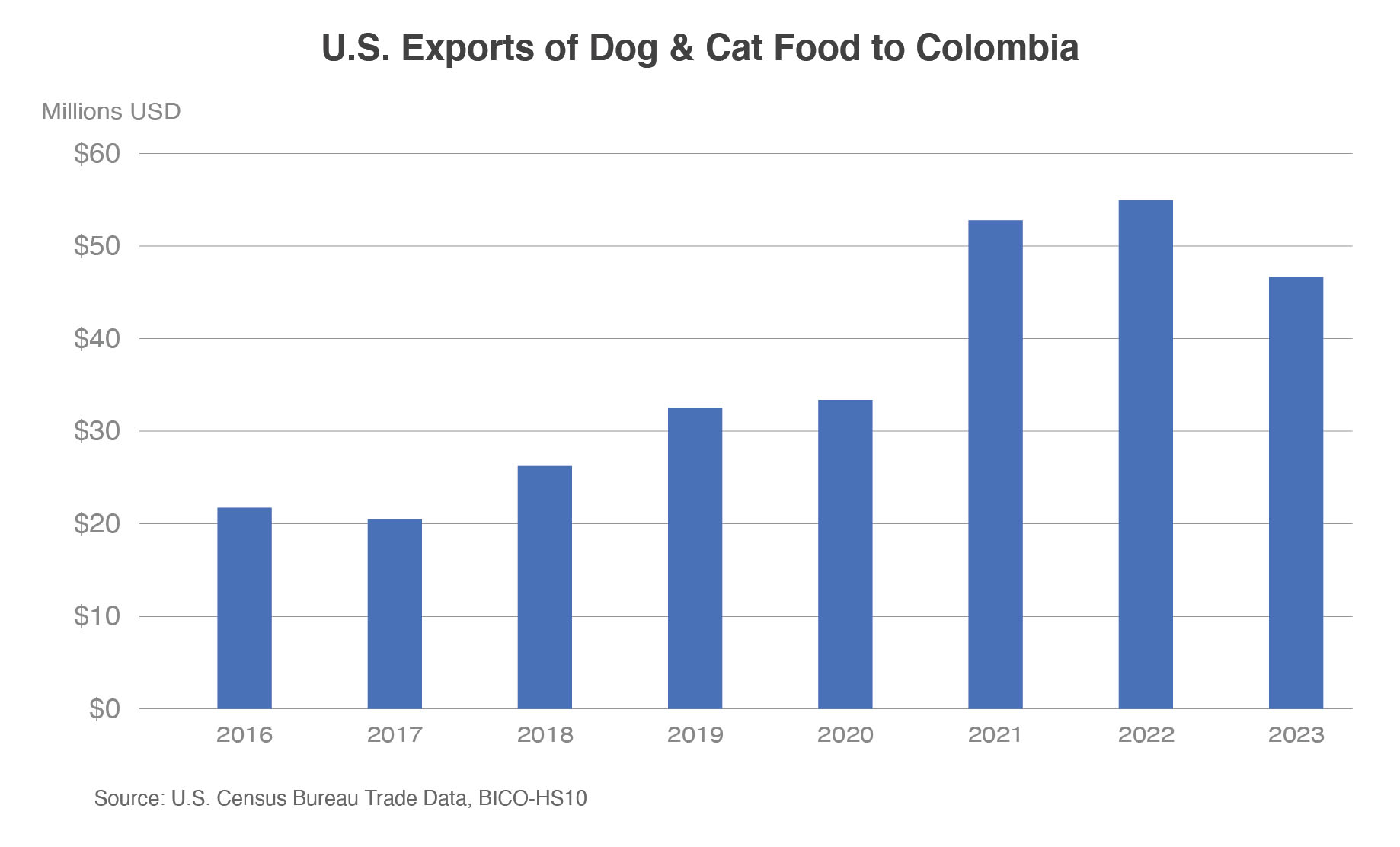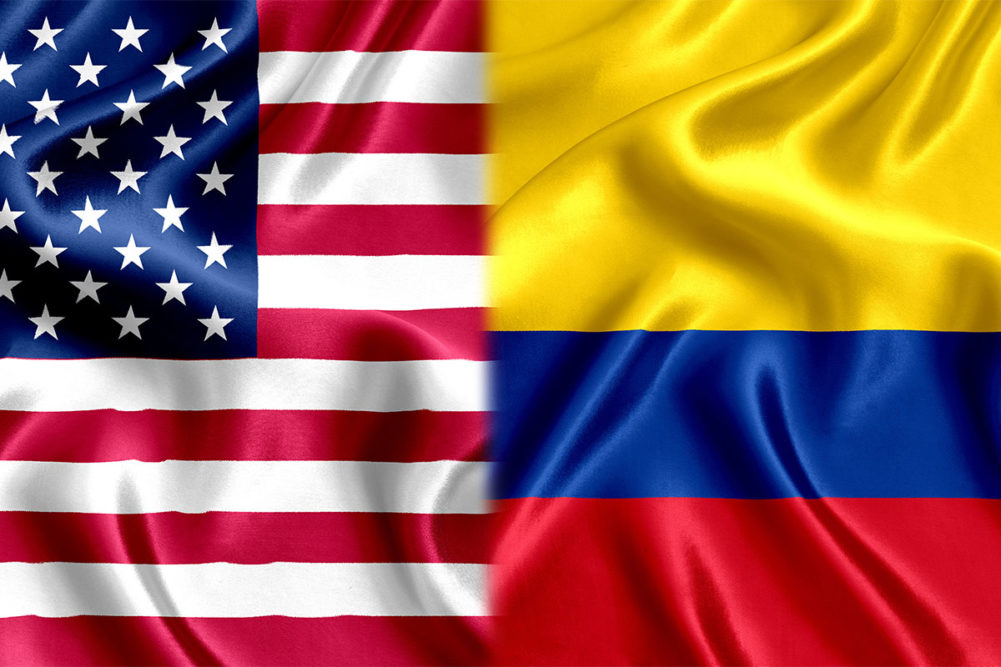WASHINGTON — With US agricultural exports to Colombia having witnessed growth of more than 235% to $3.7 billion in 2023, the US Department of Agriculture’s (USDA) Foreign Agricultural Service (FAS) has declared Colombia to be the largest South American market for several US agricultural products, including pet foods.
According to the FAS, this country is also the seventh largest for all US food and beverage products, providing a wealth of opportunities for US processors. The organization attributes this significant growth in exports to the US-Colombia Trade Promotion Agreement (CPTA) established in 2021, as well as to rises in income and retail expansions throughout the South American country, showing promise for continued interest in US products.
In 2023, 41% of Colombia’s agricultural imports originated from the United States, the largest piece of the pie. Fourteen percent came from Brazil, 9% from the European Union, 6% from Argentina and 30% from the rest of the world.
Details on Colombia
Colombia is reportedly the third-most populus country in Latin America and 80% of its 52 million inhabitants live in cities, likely translating to an increased interest in obtaining pets.
Additionally, several macroeconomic trends seen in the country are expected to benefit the US agricultural industry. According to the Economist Intelligence Unit (EIU), inflation in Colombia is expected to fall in 2024 and hit an average of about 3.5% in the next five years. And the Colombian peso has appreciated 20% in value against the US dollar since March 2023, reducing import costs for Colombian consumers.
The EIU also predicts that the country’s fiscal deficit will continue to narrow. Real gross domestic product (GDP) is also expected to average 2.8% per year through the mid-202s, higher than the Latin American average.
Looking at the country’s consumers, IHS Markit claims the number of middle-class households with incomes over $20,000 is set to rise 20% by the end of the decade. The country is also experiencing rising wages, leading to increased consumer spending across various product sectors.
Examining these consumers’ consumption trends, FAS Bogota found that traditional convenience stores (called tiendas) and markets are very common shopping venues in Colombia. However, formal retailers now account for 60% of food distribution. Shifts in the lifestyles of Colombians, including the increased prevalence of dual-income homes, has led to increased proliferation of supermarkets and mid-sized grocery stores that offer a more streamlined shopping experience.
Similar to other counties, e-commerce has also blossomed in Colombia as brick-and-mortar retailers have adopted digital sales platforms and the popularity of food delivery apps continues to rise.
Colombians are examining their lifestyles, trending toward more healthy foods and products by focusing in on nutritional profiles. These consumers are also concerned about the environment and take into account the impact of the products they purchase. As Colombians begin to seek out healthier nutrition and become more aware of the role nutrition plays on their health, it is likely that these trends will also translate into the pet space.
The pet food skinny
According to the US Census Bureau Trade Data shared by the FAS, US exports of dog and cat foods to Colombia totaled $46.6 million in 2023, the third highest value on record. Though 2023’s valuation dropped from around $55 million in 2022 and around $52 million in 2021, it remains higher than 2020 and other prior years.
 Source: US Census Bureau Trade Data
Source: US Census Bureau Trade Data
This continued increase in US pet food exports is attributed to Colombia’s expanding middle class and the rising role pets play as members of the family. Pet ownership throughout the country rose from 25% of Colombian households to 30% in the last four years.
With a steadily increasing pet population comes increased demand for pet products. According to Euromonitor International, the Colombian market for dog and cat food rose 10% year-over-year in 2023 to $1.2 billion, and is projected to rise an additional 7% through 2028.
Overall, Colombian pet parents are becoming more concerned about their pets’ health and nutrition, often switching to formulas that include natural ingredients and tout clean labels. Additionally, pet foods that offer functional benefits, like digestive or dental health, have experienced strong growth potential in the country.
Specifically, dog and cat treats are gaining much traction, ranging from traditional dry treats to those formulated with natural foods, as well as pet supplements and frozen formats, all of which Colombian consumers leverage to provide their furry companions with higher quality of life.
In November 2023, the USDA’s Animal and Plant Health Inspection Service (APHIS) secured market access to Colombia for US exports of bovine meat and bone meal, a common ingredient in pet food products, furthering US pet food processor’s access to the country.
Current policies
According to the Department of Commerce’s (DOC) International Trade Administration, Colombia currently has 17 free trade agreements (FTAs) with about 66 economies throughout the globe, including the European Union, Canada, Mexico and the Southern Common Market (MERCOSUR), which includes Argentina, Brazil, Paraguay and Uruguay.
The CPTA, which was signed in 2006 and implemented in 2012, provides duty-free access to the country for over half of US food and beverage exports, including most processed products like pet foods.
Despite enhanced market access, US processors should be aware of continued changes in Colombia’s packaging requirements. According to the FAS, Colombia’s Ministry of Health and Social Protection recently established front-on-pack labeling requirements for specific processed foods, mostly those for humans. Additionally, promotional health claims are prohibited on front-labeled packages, even if the product contains one or more healthy ingredients.
“It should be noted that the current administration in Colombia has taken trade restrictive actions on a limited basis affecting some agricultural imports, including from the United States,” the FAS noted. “Hence, US exporters should remain attentive to the political landscape within Colombia and possible trade implications of policy initiatives.”
Regarding customs, clearance in Colombia is usually fast and unproblematic, according to the FAS. However, the organization did suggest US exporters seek out Colombian importers that have legal authorization to import agricultural products from the Ministry of Commerce, Industry and Tourism (MINCIT) to ensure straightforward entry. Additionally, all nutritional labels mut be in Spanish.
With duty-free market access improving and Colombians’ pet ownership habits beginning to follow those of Americans, Colombia offers US pet food producers an opportunity to expand their international presence.
Find more articles related to pet food export opportunities and trade.




